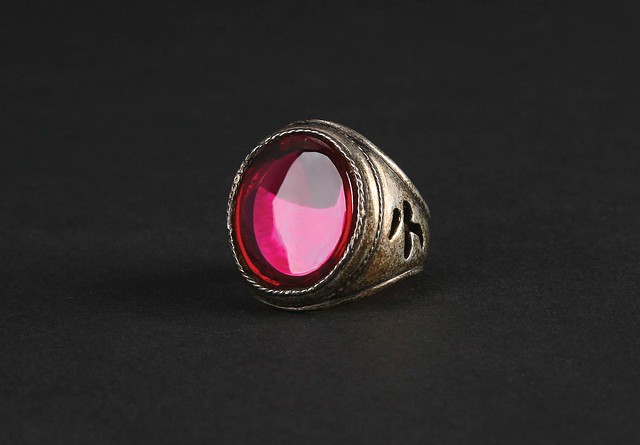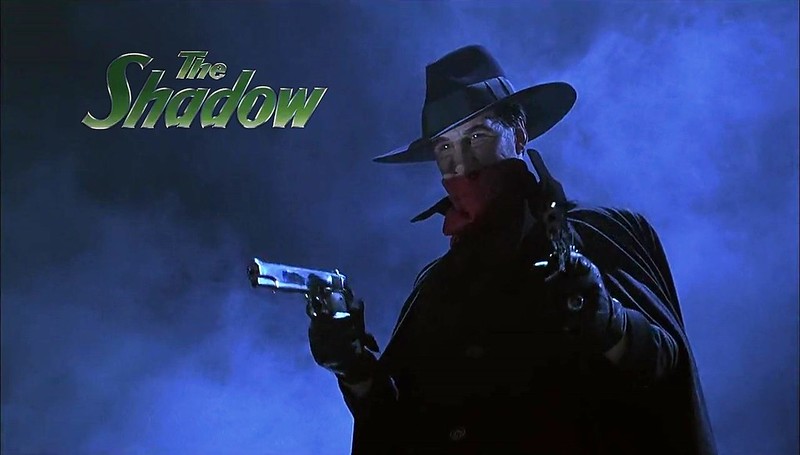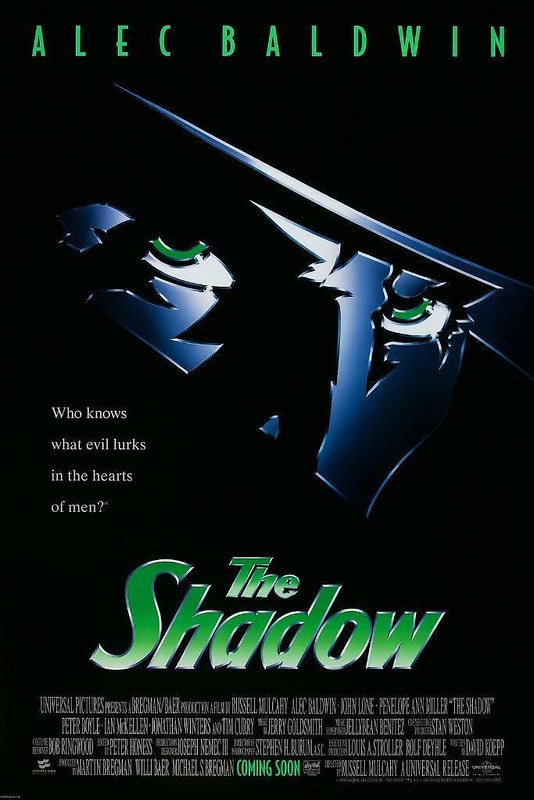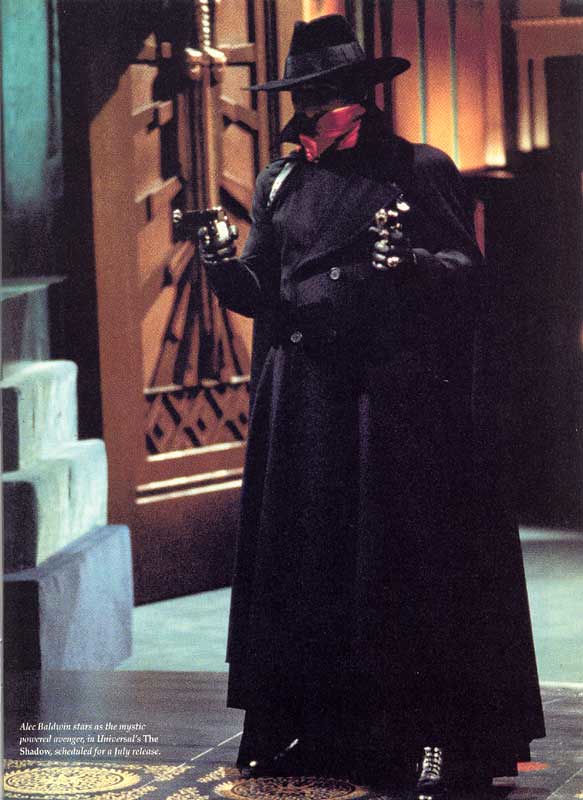When Alec Baldwin’s Lamont Cranston walks down the alley after kissing Margo Lane (Penelope Ann Miller) and disappears around the corner, there were high hopes from this viewer that he would return. But we never saw him again. We never saw his Shadow flying in an “autogyro.” Never saw him battling mad scientists or crime kingpins. No villains like The Wasp or criminal organizations like The Silent Seven. The Shadow vanished like a wisp of smoke… This month I look back at some of the reasons behind his sudden departure from movie screens.
I should preface this by saying I have always been an Agent of the Shadow. The character, whose origins date back to 1930, is my favorite “superhero.” He found the ultimate embodiment in the 1994 Universal film, The Shadow. At one time, I was in possession of the actual Shadow ring worn by Alec Baldwin in the movie. I had purchased it at Metro Golden Memories in Chicago; and yes, it came with a certificate of authenticity indicating how it had been attained. In fact, there were two rings for sale at the store– one worn on the hand and the other over the glove. I could only afford to buy the latter and had kept it for a number of years. But being oversized and fitted to be worn on a glove, I couldn’t really show it off very well.
Though the ring has since been placed in the hand of another, my love of the Shadow character has not diminished. I had always been drawn to the pulp artwork that featured him on the covers. The year 2021 is actually the 90th anniversary of The Shadow’s first appearance in print. (The Living Shadow hit newsstands on March 6, 1931.) As a fan of old-time radio, I was familiar with the Shadow radio program in which the character was first voiced by the legendary Orson Welles. And one of my favorite book discoveries as a teen was The Shadow Scrapbook (1979) by author (and Shadow creator) Walter B. Gibson. In 1994, I was a year out of high school when the film version debuted on July 1. It was one of the few movies at that time that generated real excitement for me.
Although The Shadow had appeared in a movie serial and in various B films of the 1940s, there had been nothing on the screen since. The Shadow from that era, however, was essentially just another cloaked crime-fighter and lacked the qualities that made him unique in pulps and on the radio. The character really was a media sensation in those days. It was The Shadow who in fact inspired Bob Kane’s “Bat-Man.” So with this in mind, I couldn’t wait to experience the new version of The Shadow. I remember the film being well-hyped on the entertainment shows. A whole line of merchandise was already in place!
It was a Friday night when I saw The Shadow for the first time with my friend Mike from high school. I remember that as soon as the movie was over and the lights came back on in the theatre, some older teen stood up from his seat and said, “Man, that sucked!” Our own response to the film was a minority opinion. The film took a beating at the box office and word of mouth probably didn’t help. Needless to say, for many it did not live up to the hype. It was a bomb as big as any “beryllium sphere.” On a 40 million dollar budget, the film only grossed 48 million. Hopes of a studio franchise quickly fizzled out, and to this day, The Shadow has received pretty low scores on sites like Rotten Tomatoes, which currently lists it with a 35% approval rating on the “Tomato-meter.”
Despite the negativity, I was one of those who loved the movie. (Roger Ebert was one of the few critics who gave it a positive rating.) I saw it three times that summer, and to this day, I sincerely believe it’s vastly underrated. Visually, aurally– even thematically it made an impression on me, particularly the scene in which The Shadow tries to control his emotions and stay concentrated in order to master his powers. Lamont Cranston wasn’t your typical hero; he knew darkness well enough to fight it. In the words of screenwriter David Koepp, this was “a story of guilt and atonement.”
A friend of mine told me he believed 40% of the film works, while another called it a “noble failure.” However, I maintain that the % of what works in the movie is considerably higher than 40% and that the film was a failure only in terms of its box office receipts. Like the character itself, there is more good at work than bad. Before I break down these points further, a word about what the film is actually about…
Ying-Ko, whose real name is Lamont Cranston, is a drug warlord in 1930s Tibet. He is abducted and taken to a holy man, the Tulku, who is determined to reform him. With an ability to “cloud men’s minds so they cannot see him,” Lamont returns to the United States to battle the forces of evil under the alias of The Shadow. To all appearances, he is a wealthy playboy whose uncle happens to be the police commissioner. While at the posh Cobalt Club, Lamont meets Margo Lane, a beautiful socialite who shares his abilities in telepathy. Lamont has a vast array of agents who inform him of various crimes throughout the city, including the recent murder at the local museum. Evil descends on the world when Shiwan Khan, the last descendant of Genghis Khan, arrives in the city with the intent of finishing the work of his illustrious ancestor and conquering the world. He plans to accomplish this by using his will on Reinhardt Lane, Margo’s scientist-father, who is developing the components of an atomic bomb. Also aiding Khan in his plot of world domination is Reinhardt’s assistant, Farley Claymore. It’s up to The Shadow to stop Khan and rescue Margo’s father.
What Works
1) The Shadow faithfully combines the literary and radio versions of the character into one well-realized creation. Using the pulp magazines from which to draw, the filmmakers got the look of the character down with his dark suit and cape, red scarf, and his twin .45s. They made the character as close to the Shadow Magazine version as possible while maintaining the “invisibility” from the popular radio program. The character of Margo Lane was also taken from radio. Additionally, the filmmakers went to the original source material and appropriated one of the main villains from the pulps, Shiwan Khan, who appeared in four novels. The Shadow’s network of agents and their use of secret messages to communicate with one another is also true to the spirit of The Shadow. As a purist, I appreciate the effort that was made to preserve the mythology of the character. Sadly, as those who remember the pulps and radio shows dwindle in population, less of an effort will be made by filmmakers to be true to The Shadow. He will be modernized, and it won’t be The Shadow we know. As my friend John has pointed out, “The Shadow, like Philip Marlowe, needs to remain in his time. There’s a charm to the limited tech and Art Deco feel. His surroundings were part of his character.”
2) Alec Baldwin and the cast. Baldwin made a perfect Lamont Cranston. He’s a very good actor, he has the looks, and he’s charming and debonair in the role of a wealthy man about town. But there’s one more thing: Alec Baldwin has a great voice, and that’s essential in a part like this. (Supposedly, the screenwriter had Baldwin in mind from the beginning.) I think those who have criticized Baldwin’s makeup as The Shadow missed the point; he wasn’t supposed to look like Alec Baldwin in Shadow form. He was using his ability to cloud people’s (and the audience’s) perception of him. As Lamont Cranston, Baldwin delivered some of his lines tongue-in-cheek, particularly in his exchanges with Shiwan Khan, but it was never a send-up of the character. He plays the role pretty straight, and his best moments are those in which he struggles with the darkness within himself. Around Baldwin is a wonderful cast including Penelope Ann Miller, John Lone, Ian McKellen, Tim Curry, Peter Boyle, and Jonathan Winters.
3) The Jerry Goldsmith score. It could be argued that this is the best thing about the film. It’s certainly one of Jerry’s best scores, giving the film the right atmosphere of mystery. His music makes The Shadow sufficiently weird– evoking the feel of the pulps. For me as a listener, the soundtrack adds immeasurably to the film’s hypnotic appeal. In addition to Goldsmith’s score, The Shadow benefits from Taylor Dayne’s end credits song, “Original Sin.” It’s a powerhouse cover of a song originally performed by Pandora’s Box. Dayne’s rendition does make you wonder why she never sang the title song to a James Bond film! (The music video of which features some shots not used in the film.)
4) Production and sound design. The Shadow is one of the most stylish films of the 1990s. Aside from its glamorous nightclub settings, the film re-imagines a bustling New York City of the 1930s. Particularly effective is the recreation of the Shadow’s radio network and his Sanctum. Joseph Nemec III (Terminator 2: Judgment Day) was the production designer. The Shadow also is memorable for its sound design. I remember sitting in the theatre during The Shadow’s first appearance and hearing all those bullets ricocheting around the bridge. With the surround sound, you heard them behind you, and it made you just want to duck!
5) Camerawork and special effects. The film has great visuals with cinematography by Stephen H. Burum (Apocalypse Now). The shots and compositions throughout the film show a high degree of care and inspiration. Burum, who originally wanted to shoot it Anamorphic and in black and white, knew how to light actors and make them look their very best. In several instances, old-fashioned lighting techniques were used, particularly in the scenes in which Lamont Cranston uses his mind control. Some of the memorable special effects include the point-of-view shot of a message going through a pneumatic tube and the Enter the Dragon-inspired hall of mirrors. The miniatures and matte paintings are equally exceptional. The film was made at the dawn of the CG revolution, so it incorporates both traditional and digital effects.
6) Multiple standout scenes. In recent years, I’ve seen superhero movies that made $700 million at the box office but didn’t have a single, well-constructed scene. In the case of The Shadow, however, there are several. The first is the scene on the New York bridge in which The Shadow saves Dr. Roy Tam from being tossed into the river. Had the rest of the film lived up to this one scene, The Shadow would certainly be regarded with films like The Dark Knight. Another sequence is the one inside the Hotel Monolith where The Shadow drives Tim Curry’s Farley Claymore mad. Curry does his best impersonation of Bert Lahr’s Cowardly Lion before The Shadow sends him crashing through an imagined “EXIT” sign high above the hotel lobby. Claymore’s demise reflects the pulp-era moral code of The Shadow– and it’s precisely the kind of weirdness the film needed. When you think of The Shadow, you think of the pulp magazine covers of the 1930s– with qualities evoking the bizarre, the macabre, and the exotic. More of the film, in fact, should have been tinged with a sense of madness.
7) It’s old-fashioned. It’s really old school in terms of its tone, dialogue and story. Whereas so many superhero movies now dwell on “origin stories,” The Shadow tells its backstory in eight minutes. It’s not necessary to tell more because The Shadow should remain a dark question mark. In terms of the love interest, the film is very “Old Hollywood” with its attempts at witty banter in the screwball comedy tradition. The Shadow is also very chaste and saves its one kiss between Lamont and Margo for the very end. Baldwin’s delivery of the movie’s closing line– “I’ll know!”– feels like a throwback to how a 1930s B action movie might have ended. It certainly has the feel of something from an earlier time. The Shadow is a visual interpretation of 1930s escapism. And yet there’s something more at work than just the images and the recreations like the Art Deco Cobalt Club. It’s the film’s overall attitude. The Shadow embraces the past and remains true to it. To its credit, it wasn’t “updated” to the times. Its use of quotes from the radio show, for example, tie it explicitly to the past. The film has all the color and visual dynamics of the pulp covers while maintaining the tone of the radio series. In this way, the film plays as a celebration of The Shadow’s legacy.
What Doesn’t Work
1) The comedy. Supposedly, early drafts of the film were either too dark or too comedic; the final version finds a balance between the two. Although the film is generally played straight, there are a few lines in David Koepp’s script that were unnecessary– “groaners,” as I would call them. There’s a nice sequence in which The Shadow battles one of Shiwan Khan’s warriors on the balcony of a federal building. The two tumble over the edge and land on a stone sculpture, only to have The Shadow say, “Next time you get to be on top.” (groan) It’s completely out of character, and as a joke it falls completely flat. Later, while Peter Boyle is waiting by his taxi and reading a book about how to develop one’s psychic ability– “I sense someone is coming,” he says– we see one of the villains hit the pavement behind him. There’s actually a third joke that comes later while a sailor is falling from a building. These lines could’ve easily been excised. The producers may have been trying to lighten the mood, but The Shadow should be dark. One sequence that is more problematic is the infamous “rolling beryllium sphere” gag in which the atomic bomb breaks loose and starts rolling down the hotel hallways and down a flight of stairs before finally crashing through an elevator gate. This was perhaps a homage to the rolling boulder in Raiders of the Lost Ark, but it really doesn’t belong here. The best that can be said of it is that at least it was a practical effect. It’s pure speculation on my part, but this feels like something that may have been forced on the director by a nervous studio hoping to keep it light.
2) Climactic action sequence– or lack thereof. Although there are some fine action scenes in the film– it’s certainly never boring (like modern superhero movies with their 20-minute action sequences)– The Shadow needed an epic conclusion. Reportedly, a longer sequence was conceived for the ending, but a 6.7 magnitude earthquake during production destroyed the “hall of mirrors” set and curtailed what had been planned.
3) Editing. The editing is generally quite good, but there is a sense that the film was trimmed perhaps too much. There’s a scene in which Shiwan Khan and Lamont Cranston meet for the first time in Lamont’s Sanctum. At the end of which, Khan departs somewhat dramatically, but then he is seen immediately in the very next shot with an overhead camera angle. Dramatically, there should have been some separation from Khan at this point. When The Shadow later enters the Hotel Monolith, he confronts Farley Claymore, but what about the other warriors who were also sent out to find him in the hotel? They are never seen again! In both instances, it feels as though something may have been cut out. The Shadow is only 108 minutes. It’s lean, but probably too lean compared to today’s bloated superhero epics. Based on shots seen elsewhere, as in the trailers, it appears that footage was removed. Some of these shots are extraordinary– such as a bird’s-eye view of The Shadow slugging one of Khan’s warriors on the building balcony. Had the film been a success, perhaps there would be hope of seeing this additional footage.
The above faults are relatively minor. The Shadow failed primarily because of two reasons. Although it finished #2 at the box office in its opening week, it was pummeled week after week with the release of films like The Lion King, Forrest Gump, True Lies, and The Mask. (I’d recommend The Shadow over all four of these.) The second reason the film failed is that The Shadow had no connection to pop culture. He’s a thing of the past and not like Superman or Batman, who continue to appear on television and in the comics. People just didn’t “get it”– particularly younger audiences who had no cultural understanding of the character’s history. When The Shadow tells Roy Tam in the taxi, “The Shadow knows,” fans love hearing that iconic line. It’s what makes the film so fun. But the kids in the audience didn’t care. What was cool for me as a fan was probably lame to them.
The Shadow was made in the days when the Hollywood studios weren’t willing to invest in the major comic book properties, such as those in the Marvel Universe. Secondary characters were exploited instead– characters like The Rocketeer, The Phantom, and The Shadow. None of which produced a sequel. The superhero film has since undergone a renaissance in film and on television, at least with the Marvel properties, but back in 1994, we weren’t quite there yet. Timing is everything, and The Shadow just came out at the wrong time.
“The mystic powered avenger…”
Russell Mulcahy’s version of The Shadow remains the best representation of the character on screen and laid the foundation for what will come. The character has a rich history, particularly in the pulps, and it would be a shame if the property was not resurrected again. Director Sam Raimi (Spider-Man) tried to launch a remake but never quite found a script to do the character justice. Perhaps, instead, an on-screen teaming with a 1940s version of Batman would help The Shadow’s prospects. Or simply a cameo in which The Shadow saves Batman. It’s an idea for a town that lacks them. Hollywood is a derivative place and will milk properties to death. Does the world need nine Fast and Furious movies or two dozen Star Wars projects in development? But those franchises continue to make money, and that’s something The Shadow, despite a treasure trove of cinematic potential, could not do when it was released.
Until that day when The Shadow returns, we have the 1994 film to revisit, analyze, and discuss. In 2024, I plan on screening it at the Pickwick Theatre Classic Film Series for its 30th anniversary. I doubt this event would jump-start any kind of broad reappraisal of the film. (Some do call it a “cult film.”) But at least for one night anyway, audiences who come out will hopefully feel the kind of excitement I had in ’94 when The Shadow first appeared on movie screens.
~MCH
My Rating: *** 1/2
Recommended Version: Collector’s Edition Blu-ray released by Shout Factory (2012).
For more about the history of The Shadow, visit my Facebook group, The Shadow’s Sanctum.
A Shadow ring. I owned the original at one time. (I wrote to Alec Baldwin about this film and he was kind enough to send me an autograph.)
Alec Baldwin brought a dark edge to Lamont Cranston (aka The Shadow).




One thought
Comments are closed.